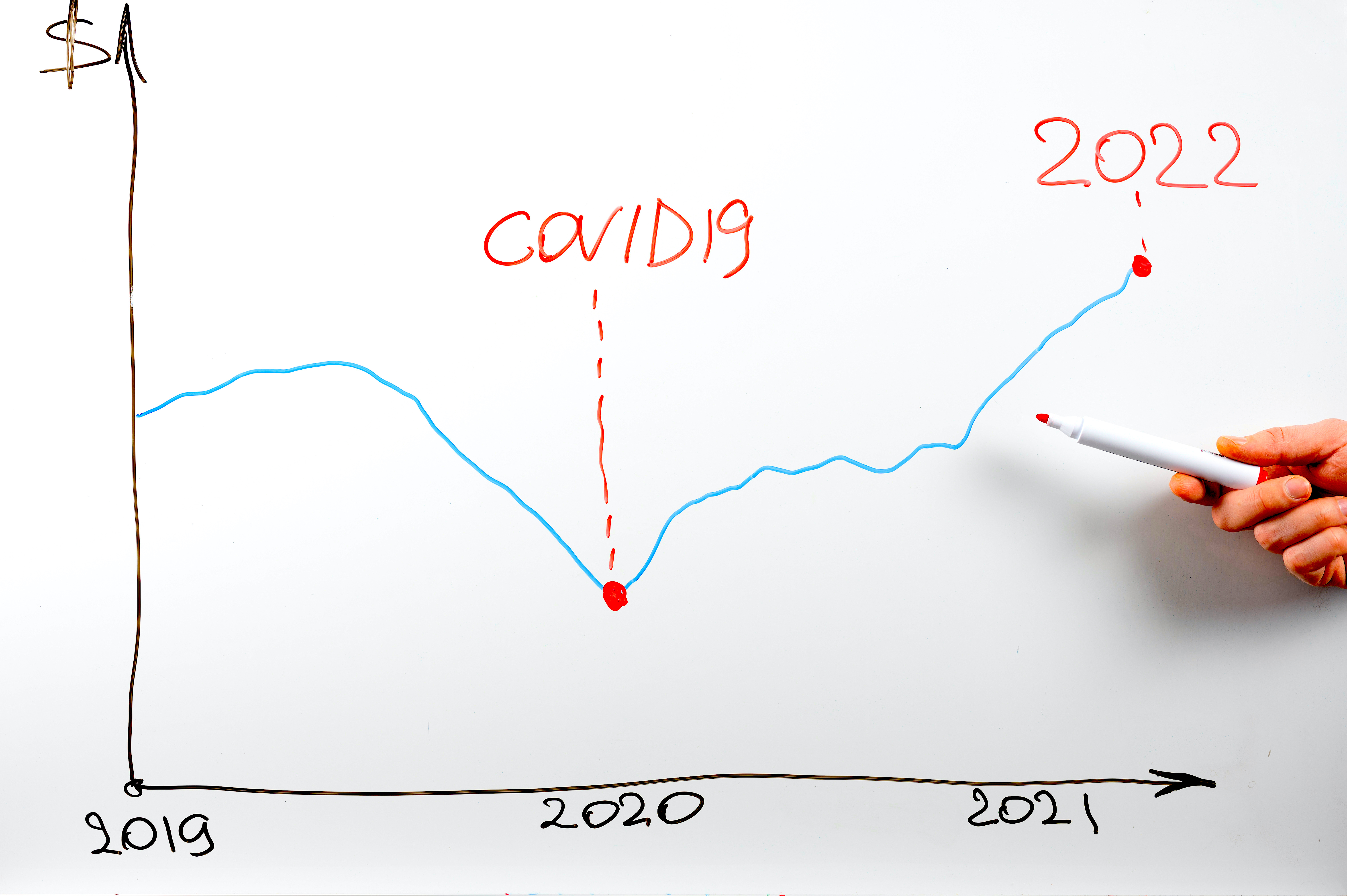 CLOUD
CLOUD
 CLOUD
CLOUD
 CLOUD
CLOUD
Predictions are all the rage this time of year. On Dec. 29, 2020, in collaboration with Erik Porter Bradley of Enterprise Technology Research, we put forth our predictions for 2021.
The focus of our prognostications included tech spending, remote work, productivity apps, cybersecurity, initial public offerings, special-purpose acquisition company, mergers and acquisitions, data architecture, cloud, hybrid cloud, multicloud, artificial intelligence, containers, automation and semiconductors. We covered a lot of ground!
In this Breaking Analysis, as a warmup for our 2022 predictions post, we’ll review each of our predictions for this past year and grade the accuracy of our forecasts.

Our first prediction was that tech spending would rebound to 4% growth this year – coming off what we had thought was a contraction in 2020. Best case was flat in 2020 depending on which data you choose. We correctly called the continuation of the remote work trend and the positive impact it would have on personal computers and the like, but we underestimated the shape of the spending bounce-back curve. We highlighted in red some of the areas that didn’t happen to the degree we expected.
IDC has 2021 tech spending growth at 5.5%, so we feel that, while we called the bounce-back, it was more pronounced than we thought. In fact, that IDC number we think is probably going to go up even higher – we’ll address that in our 2022 prediction. So B- for a grade on this one.
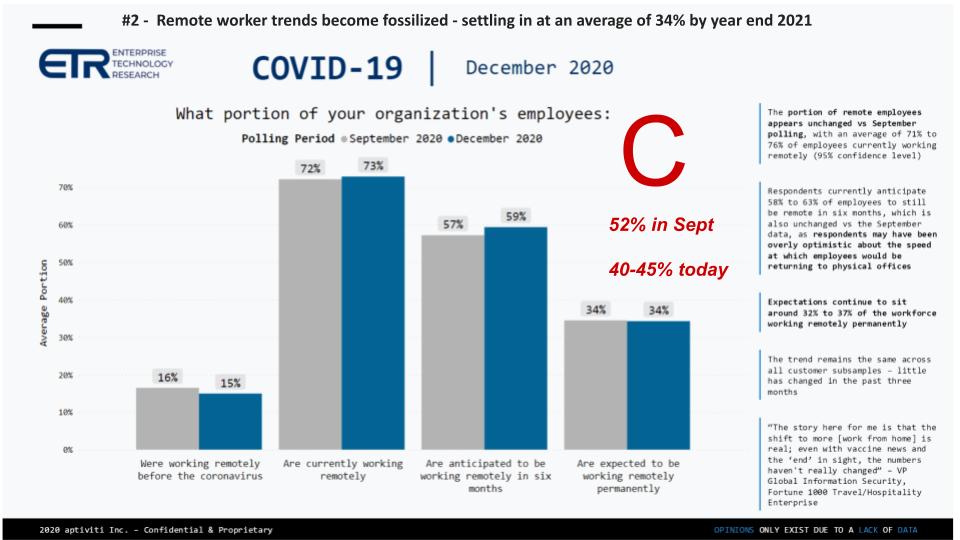
We made a precise call, but we missed Delta and now Omicron. We said that the number would settle at 34% remote by yearend, twice historical norms. But the ETR data suggests it was 52% in September and it’s probably going to be somewhere in the 40% to 45% range by the end of year.
Roughly 75% of the workforce is still working either fully remote or in a hybrid model and hybrid work is probably going to be a dominant trend. So we’ll have to revisit our assumptions and framework on how we think about this and will do so in our 2022 predictions. But we’ll give this a C grade. It’s not a total fail because we accurately called the permanence of the trend, but the percentage was well off the mark thanks to the variants and cultural shifts supporting hybrid models.
So not a great start for Erik and me, but we rebounded with the next one.

Our call was that the productivity increases seen in 2020 would lead organizations to double down on the productivity apps cited above. To measure this, we said let’s look at the most recent quarterly earnings and gauge revenue growth as an indicator. DocuSign Inc. was up 42%, Smartsheet Inc. increased 46%, Twilio Inc. jumped 65%, Zoom Video Communications Inc. growth fell 35% from 325%, confirming our layup call that Zoom growth would moderate. Microsoft Teams has never seen greater adoption. Hundreds of companies have 100,000 or more Teams users and thousands have 10,000 users or more.
So we feel like we nailed this and will give us an A+ on this one.
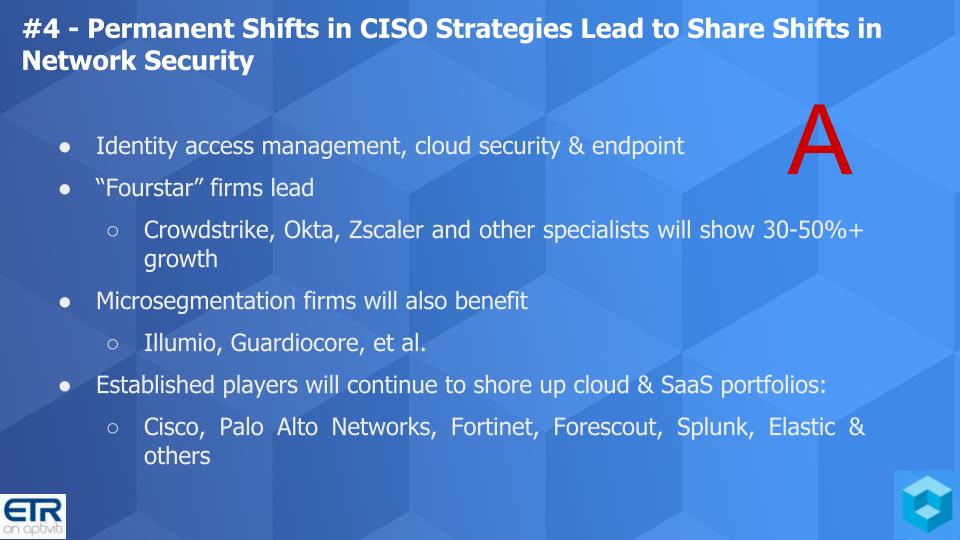
On to our cybersecurity predictions. It’s an area we’ve been making calls in for a couple of years now and we were really pleased looking back here. We said that identity, cloud and endpoint security would continue to benefit and named CrowdStrike Holdings Inc., Okta Inc., Zscaler Inc. and a few others that would benefit and substantially outpace the market growth.
Gartner has the security market growing at 11% for 2021. By comparison, Okta and Zscaler revenues last quarter grew 62% year over year and CrowdStrike grew 3%. Illumio Inc. raised $225 million on a $2.75 billion valuation on the strength of its growth. In September, Akamai Technologies Inc. acquired Guardicore for $600 million as a ransomware protection play – paying a huge revenue multiple for the company. And it seems the companies listed on the last line of the slide above are all emphasizing their business shift toward subscriptions, software as a service, annual recurring revenue and remaining performance obligations.
We feel very good about this look back and will take the A on this one. Not an A+ because we were too conservative on the growth of the newer companies. But pretty good nonetheless.

You might feel this prediction was an easy call, but not really when you dig in. The prediction was that increased tech spend would drive even more IPOs, SPACs and M&A, and perhaps that was obvious. According to SPAC Analytics, IPOs were up 109% this year. The “SPAC attack” continued– SPACs were up 109% in 2021 on top of a record 2020. And according to KPMG, M&A dollar volume was up 19%.
OK, but there was much more underneath this prediction. We called out UiPath’s IPO – which was a lock — but also said Automation Anywhere would also go public. UiPath did, AA didn’t. We did correctly call the Hashicorp IPO and Cloudflare Inc. grew revenue 219% last quarter, but Akamai was not acquired. So the degree of difficulty on the overall prediction wasn’t high, and the AA and Akamai events didn’t happen, but we think this still deserves a B grade.
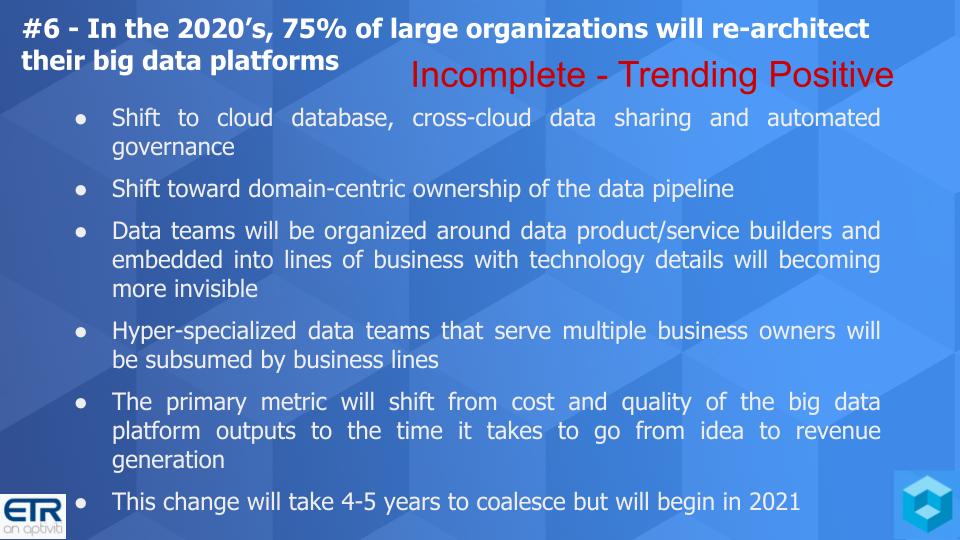
As you know, data is one of our favorite topics and we’ve reported extensively on the successes and failures of so-called big data. We said that 75% of large organizations will re-architect their big data platforms in the mid-term.
Now again, you may say this was an easy call, but you have to evaluate the prediction based on the underlying comments. The jury is still out on things like Snowflake Inc.’s data cloud, but we absolutely believe that it’s the right direction and a highly viable strategy.
Competing with Snowflake however, you have Databricks Inc. taking a different approach. It comes at the problem from the data science angle trying to take on traditional business intelligence. And there’s Snowflake coming from the analytics space and moving into AI and data science. We asked Benoit Dageville, co-founder and president of products at Snowflake, on theCUBE if there needs to be a semantic layer to bring these worlds together and he said, “Yes” — and that’s what he claims Snowflake is building.
Meanwhile, the big whales such as Oracle Corp. continue to invest in their capabilities to try to eliminate data movement (such as with MySQL Heatwave). Then there’s Amazon Web Services Inc. taking a totally different approach to data, where it gives customers maximum optionality of offerings. And you can’t forget Microsoft Corp., Google LLC and a spate of other database and data management vendors.
The reason this isn’t a layup call is that many customers might continue to take an incremental low-risk approach to data architecture on account of years of technical debt. They may not take the steps that we predicted above, such as a shift toward domain ownership and data product thinking and the reorganization of hyperspecialized technical teams — many of the principles put forth in the data mesh concept.
And we’ve said this change is going to take a number of years to play out but we’d start noticing in 2021 and that’s clearly been the case as we’ve reported on parts of JPMorgan Chase & Co. rethinking its data architecture, Hello Fresh SE and many others.
So we grade the results of this prediction as still incomplete – but we think it’s trending in the right direction.
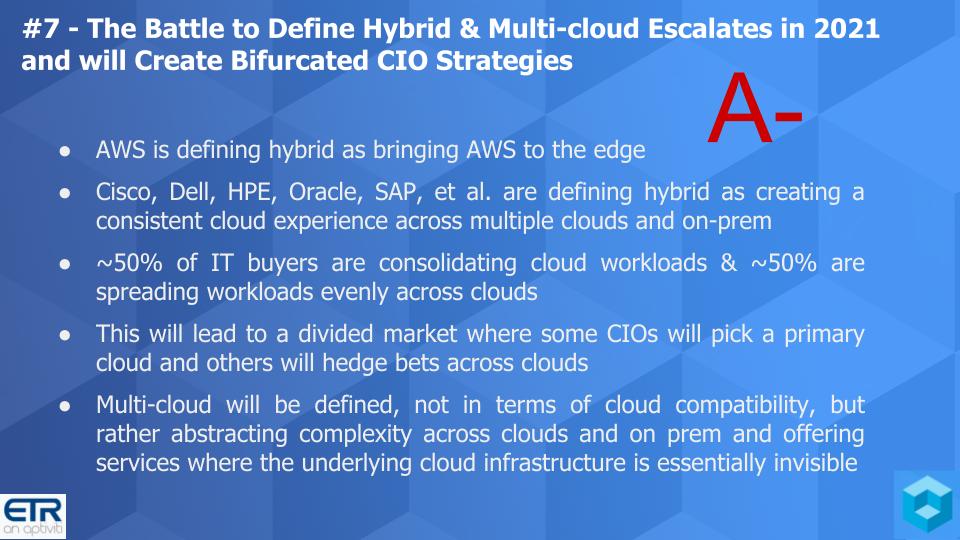
This next one is always a fun discussion.
AWS, the inventor of cloud, sees the world as bringing its application programming interfaces, primitives and programming model to the edge. The data center to AWS is just another edge node. The company says that in the fullness of time, all data will be in the cloud. And AWS would say to all this hybrid talk of connecting on-premises to a cloud: “That’s not cloud.”
Then you have the likes of Cisco Systems Inc., Dell Technologies Inc., Hewlett Packard Enterprise Co. and others saying, “Hold on — cloud is an operating model, not a place.” And AWS might say, “Yeah — and AWS along with its customers is defining the cloud operating model.” And these other guys would say, “No… actually you’re not– we are with our customers.” This battle 100% escalated in 2021 with the launch of Apex by Dell, HPE’s focus on GreenLake, Cisco’s as-a-service models and others such as IBM Corp. piling on. And then of course Oracle, which actually announced a true same:same public-to-on-prem hybrid capability two years before AWS announced Outposts.
The other nuance here is a concept we introduced called “supercloud,” which refers to the notion that multicloud is not about compatibility on an individual cloud, rather it’s about abstracting the complexity of the underlying cloud(s) and building valuable cloud services on top of the hyperscalers.
Some people didn’t like the term supercloud, but we’ll continue to use it to describe this capability. And we’re seeing new examples such as Goldman Sachs Group Inc.’s financial cloud running on AWS. So a supercloud to us is not an application or SaaS running on a single cloud, rather it’s an abstracted service that either spans multiple clouds or, in the case of Goldman Sachs, runs on a single cloud as a portfolio of data, tools, software and services made accessible as a service that floats on top of a single or multiple clouds.
Regardless, we feel that this was a correct call given the evidence and will give ourselves an A- grade here — taking off points for the somewhat anecdotal and observational measurement system applied to this prediction.

We used the graphic above to both predict and measure this call. It plots survey data for the various technologies in the ETR taxonomy. Net Score or spending momentum is on the vertical axis and Market Share or presence in the data set on the horizontal axis. That dotted line is the 40% mark and anything above that on the vertical axis is considered highly elevated and these four areas have held serve this year based on recent ETR survey data.
We predicted they would remain the big four and stay above that 40% line in the survey and and so this prediction came in correctly. We’ll take an A grade for this one too.

Our penultimate prediction went back to automation, as shown above. We came back to automation, saying the automation mandate accelerates in 2021 and goes mainstream.
We’ll give ourselves a B grade on this one, going back to the Automation Anywhere and UiPath go public predictions. AA, as we said, didn’t, and that was off. But we definitely saw companies leaning hard into automation in 2021.
Microsoft, despite the fact that it doesn’t have as rich a feature set as UiPath and AA, remains a large presence. We spoke with many customers at the UiPath Forward IV event in Vegas this year who confirmed this statement, but at the same time, many are using Microsoft Power Automate. And that product shows up as a leader in the Gartner Magic Quadrant, so it can’t be ignored. But clearly the two leaders in robotic process automation have a sizable product advantage relative to the legacy software players.
Now if you look at the comment on Pegasystems Inc., it cooled off as measured by its stock price. Revenue grew 13% last quarter on a year-on-year basis, so perhaps we overestimated the company’s momentum, but the company continues to grow at a double-digit pace. So all told, we did OK on this prediction. Correct call on the automation trend and the big software vendors piling in, but the chance we took on AA was a miss.

Our last prediction vectored into the trends in edge computing that will support new system architectures.
Much of this prediction related to the observation that Arm Ltd. was dominating at the edge and would find its way into mainstream enterprise workloads. And that clearly came into focus in 2021 as AWS announced Graviton 3 and new inference and training silicon, based on Arm. Microsoft, Google, Alibaba Group Holding Ltd., Oracle and others are all now shipping or readying to ship Arm-based systems. New storage, networking and security hardware systems are very typically including Arm-based processors to assist with offloads.
Finally, Intel is definitely under pressure as we predicted. Even Chief Executive Pat Gelsinger has admitted this is a turnaround that will take at least five years.
We’ll take an A- grade on this one, taking off points for the fact that 5G rollouts and edge are evolving and this is a longer-term trend. But the underlying points we made on this slide are solid. Today’s edge computing, led by mobile, is pointing the way to new system architectures in the enterprise.

If we use the following scale — A+ is 100 out of 100, A- is a 90, a B is an 85, B- is an 80 and a C is a 75 out of 100; and we exclude the incomplete prediction on data architectures — we average out to an 87.8. So that’s a solid B+.
The professor in us said this was a good effort as most of the predictions could be quantified or we tried to score them objectively. There were some layups in there, so we may try to take more risks in our 2022 post. Or maybe not, as it’s always good to have some locks in there to help the average – we’ll see. And it was good that we only had one or two multiyear predictions.
What do you think? How did we do on these predictions? We welcome your input.
We’re currently working on our 2022 predictions and will release those in the next few weeks. So stay tuned for that.
One note: Over the past several weeks we’ve been inundated with inbound emails, pitching us on various predictions and trends in these and other areas. The predictions folder we’ve compiled is eight inches thick with printed material!
To our PR friends that have reached out, thank you. We would observe that many of the predictions we receive are observations of trends and not really predictions. Some are self-serving marketing statements – which is to be expected. For us, we feel predictions should be measurable so we can look back and ask, “Did they get it right?” Granted, there are gray areas, so that’s why we used a grading system today.
We received many really well done and thought-proving predictions. Here’s an example of a one we received that we feel is strong and very helpful. It’s from Equinix. Think of it as a bonus prediction from the community:
Within the decade, data centers will be powered by 100% renewable energy — Milind Wagle, CIO, Equinix
We can’t promise to use any of the thousands of predictions we’ve received and we’ve tried to read them all. But the volume over the past week was so overwhelming we couldn’t keep up. We’ll try to scan them all before we do our 2022 predictions and hopefully this example helps folks understand the types of outreach that are most useful.
Remember we publish each week on Wikibon and SiliconANGLE. These episodes are all available as podcasts wherever you listen.
Email david.vellante@siliconangle.com, DM @dvellante on Twitter and comment on our LinkedIn posts.
Also, check out this ETR Tutorial we created, which explains the spending methodology in more detail. Note: ETR is a separate company from Wikibon and SiliconANGLE. If you would like to cite or republish any of the company’s data, or inquire about its services, please contact ETR at legal@etr.ai.
Here’s the full video analysis:
All statements made regarding companies or securities are strictly beliefs, points of view and opinions held by SiliconANGLE media, Enterprise Technology Research, other guests on theCUBE and guest writers. Such statements are not recommendations by these individuals to buy, sell or hold any security. The content presented does not constitute investment advice and should not be used as the basis for any investment decision. You and only you are responsible for your investment decisions.
Support our mission to keep content open and free by engaging with theCUBE community. Join theCUBE’s Alumni Trust Network, where technology leaders connect, share intelligence and create opportunities.
Founded by tech visionaries John Furrier and Dave Vellante, SiliconANGLE Media has built a dynamic ecosystem of industry-leading digital media brands that reach 15+ million elite tech professionals. Our new proprietary theCUBE AI Video Cloud is breaking ground in audience interaction, leveraging theCUBEai.com neural network to help technology companies make data-driven decisions and stay at the forefront of industry conversations.